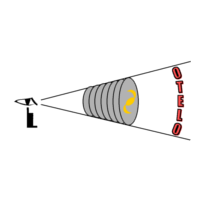Active Galactic Nuclei
Active Galactic Nuclei are one of the most interesting objects in the Universe, with violent phenomena such as accretion and extremely energetic emission going on. They are an essential tool when studying the evolution of galaxies, as it is nowadays believed that they constitute one of the phases in galaxy formation. OTELO survey will allow selecting AGN in the field by means of their optical emission lines and also with their mid-infrared and X-ray emission. The discrimination between AGN and star-forming galaxies will be possible with diagnostic diagrams, as well as the classification of the different types of AGN. Moreover, different luminosity functions will be built in order to trace the luminous content of the Universe at different epochs. The morphology of AGN will also be studied, as well as their spatial distribution and the fraction of LIRGs and ULIRGs found. All of this will constitute an important insight into the AGN population in the field, and may be used to deduce fundamental astrophysical constraints when comparing with AGN in clusters, among other possibilities.
In recent decades, research on active galactic nuclei (AGN) has become one the most popular fields of astrophysics. Many fundamental questions regarding their origin, energy production mechanism, and relationship with their host galaxies still remain unanswered. For instance, we do not know if all galaxies pass through cycles of activity or whether such activity is related to their structural characterization. Some of the many yet open issues include the density of active galaxies and the faint end of the AGN luminosity function, and the stricking dichotomy observed in the Hubble type distribution of nearby galaxies hosting AGN and nuclear star forming regions.
The OTELO survey will provide an effective tool to address these and other important questions. It will be the deepest Hα narrow band imaging survey of emission line galaxies (ELGs) using OSIRIS tunable filters at the GTC. Its ability to separate Hα and [NII] will allow to discriminate AGN from nuclear star forming galaxies. It will be able to detect Hα luminosities as weak as 5 x 1039 erg s-1 over a region a 6 kpc diameter at 5σ level in well-defined Universe volumes, since redshift bin widths at different z will be equivalent in cosmological time and the projected line of sight areas covered will be such that volumes at different z are equivalent.
The use of tunable filters will allow the separation between the Hα and [NII] lines; therefore, a standard emission line ratio diagnostic method can be used to separate AGN from nuclear starbursts.
The ability of the tunable filters to separate between Hα and [NII] is accomplished by: a) tunable filter scanning through a spectral range covering both lines; b) the scanning steps being a fraction of the filter FWHM (flux accuracy about 1% can be reached); and c) line profile recovery using Lucy or factorized deconvolution of the scan spectrum and the tunable filter Airy profile. It is also possible to recover the flux of Hα and [NII] lines without deconvolving the scan spectrum by solving the appropiate system of equations involving the continuum-subtracted image fluxes, the tunable filter transmissions, and the line fluxes wavelengths.
See also: Related Publications
